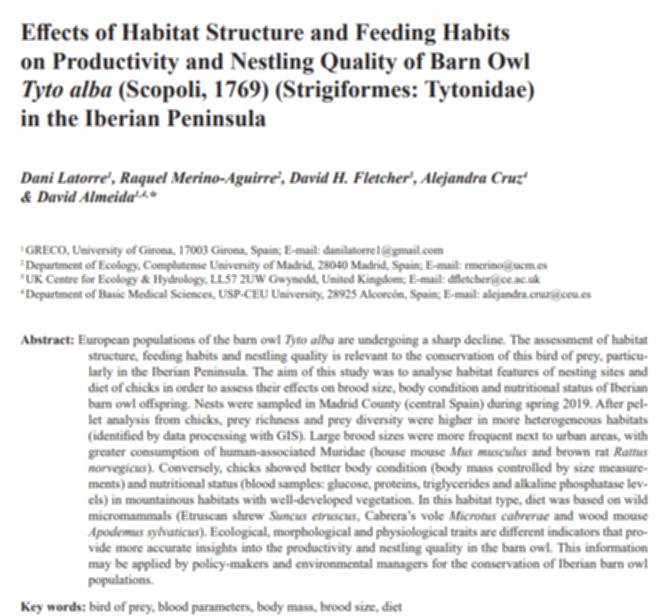Please use this identifier to cite or link to this item:
http://hdl.handle.net/10637/15164Effects of Habitat Structure and Feeding Habits on Productivity and Nestling Quality of Barn Owl Tyto alba (Scopoli, 1769) (Strigiformes: Tytonidae) in the Iberian Peninsula

See/Open:
Effects_Latorre_et_al_Acta_Zool_Bulg_2022.png
210,96 kB
image/png
See/Open:
Effects_Latorre_et_al_Acta_Zool_Bulg_2022.pdf
Restricted Access
398,42 kB
Adobe PDF
Request a copy
| Title: | Effects of Habitat Structure and Feeding Habits on Productivity and Nestling Quality of Barn Owl Tyto alba (Scopoli, 1769) (Strigiformes: Tytonidae) in the Iberian Peninsula |
| Authors : | Latorre, Dani Merino-Aguirre, Raquel Fletcher, David H. Cruz Varona, Alejandra Almeida Real, David |
| Keywords: | Bird of prey; Blood parameters; Body mass; Brood size; Diet |
| Publisher: | Institute of Biodiversity and Ecosystem Research, Bulgarian Academy of Sciences, |
| Citation: | Dani Latorre; Raquel Merino-Aguirre; David H. Fletcher; Alejandra Cruz; David Almeida (2022). Effects of habitat structure and feeding habits on productivity and nestling quality of barn owl Tyto alba (Scopoli, 1769) (Strigiformes: Tytonidae) in the Iberian Peninsula. Acta Zoologica Bulgarica, 74(2):203-214. Bulgarian Academy of Sciences. Junio 2022 (Online: 10/03/2022). ISSN: 0324-0770 (print). ISSN: 2603-3798 (online). |
| Abstract: | European populations of the barn owl Tyto alba are undergoing a sharp decline. The assessment of habitat structure, feeding habits and nestling quality is relevant to the conservation of this bird of prey, particularly in the Iberian Peninsula. The aim of this study was to analyse habitat features of nesting sites and diet of chicks in order to assess their effects on brood size, body condition and nutritional status of Iberian barn owl offspring. Nests were sampled in Madrid County (central Spain) during spring 2019. After pellet analysis from chicks, prey richness and prey diversity were higher in more heterogeneous habitats (identified by data processing with GIS). Large brood sizes were more frequent next to urban areas, with greater consumption of human-associated Muridae (house mouse Mus musculus and brown rat Rattus norvegicus). Conversely, chicks showed better body condition (body mass controlled by size measurements) and nutritional status (blood samples: glucose, proteins, triglycerides and alkaline phosphatase levels) in mountainous habitats with well-developed vegetation. In this habitat type, diet was based on wild micromammals (Etruscan shrew Suncus etruscus, Cabrera’s vole Microtus cabrerae and wood mouse Apodemus sylvaticus). Ecological, morphological and physiological traits are different indicators that provide more accurate insights into the productivity and nestling quality in the barn owl. This information may be applied by policy-makers and environmental managers for the conservation of Iberian barn owl populations. |
| URI: | http://hdl.handle.net/10637/15164 |
| Rights : | http://creativecommons.org/licenses/by-nc-nd/4.0/deed.es |
| ISSN: | 2603-3798 |
| Issue Date: | 10-Mar-2022 |
| Center : | Universidad San Pablo-CEU |
| Appears in Collections: | Medicina |
Items in DSpace are protected by copyright, with all rights reserved, unless otherwise indicated.

